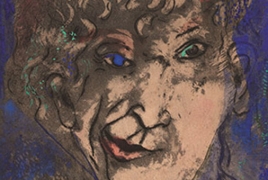
Christie’s Mayfair presents Reflections on the Self: From Dürer to Struth, an exhibition which celebrates and surveys the changing face of self-portraiture from the 1400s onwards. While focusing on the apogee of the genre in the 20th and 21st centuries, Reflections on the Self seeks to explore the history and evolution of the self-portrait. Curated by specialists Cristian Albu and Jacob Uecker, the exhibition will take place at Christie’s Mayfair, London from June 2 until September 5, 2015, Art Daily reports.
Featuring over 50 artists and 70 works, the exhibition will highlight the different formats and styles artists employ to depict themselves across a range of media including painting, print, sculpture, collage, and installation. The exhibition begins with The Bathhouse (circa 1496-97), a rare 15th-century woodcut by the first prolific self-portraitist, Albrecht Dürer, and includes works by Marlene Dumas (The Space Age, 1984), Lucian Freud, Francisco Goya, Barbara Hepworth, Sarah Lucas, Henri Matisse, Rembrandt van Rijn, and many more.
Francis Outred, Chairman & Head of Post-War and Contemporary Art, EMERI at Christie’s said of the exhibition: “Today, in an age of selfies and avatars, the self-portrait has never been more relevant. Technology has driven the self-portrait to become one of the most popular visual genres and it remains one of art history’s most enduring phenomena. Juxtaposing carefully selected works by artists that have championed this art form in wildly varied ways, the exhibition seeks to expand the parameters of the genre beyond the traditional idea of a window into the artist’s soul.”
As a cultural symbol, self-portraiture is a visual genre that captures both an intimate existential moment and the intellectual and cultural climate of its time. Born out of the natural curiosity for the individual, each work puts in play a tension between an act of great personal scrutiny and the artistic, social, technological and political context of its era.
Seen in Lucian Freud’s series of brutally honest self-portraits which begin with a painting of the young artist in Self-Portrait 1949, and progresses through the decades including Self-Portrait with a black eye, 1969, Reflection (Self-Portrait), 1985 and Self-Portrait: Reflection, 1996 when the artist was in his 70s, the development of the artist’s skill and self-awareness can be discovered in the diary-like intimacy shared by the painter. Known for his supposedly objective image of people and his belief in “paint[ing] what I see, not what you want me to see”, his psychologically penetrating works capture the inherent power of the self-portrait.
The works assembled will not only chronicle the likenesses, revelations and confessions of the tradition’s most important exponents, but also create unexpected encounters between these depictions of self. Andy Warhol’s detached, mass-produced 1960s self-portraits will provide a point of contrast to Francis Bacon’s twisted, tormented Three Studies for Portraits (including Self-Portrait), 1969.
Alongside the more traditional self-portrait media of painting and photography, including Sarah Lucas’s confrontational Self Portrait with Skull and Robert Mapplethorpe’s reflection on lost youth Self Portrait, there will be three-dimensional representations of the self, including a rendered bronze sculpture of the hand of Dame Barbara Hepworth, The Artist’s Hand (1967), Joseph Beuys’ Felt Suit (1970), and culminating with prankster Maurizio Cattelan’s WE (2010).
The exhibition will be accompanied by a catalogue featuring essays by author James Hall on the history of self-portraiture and Francis Bacon scholar Michael Peppiatt.
Reflections on the Self is the sixth exhibition to be presented at Christie’s Mayfair, following on from the celebrated exhibitions When Britain Went Pop, Turn Me On: European and Latin American Kinetic Art 1948-1979, Richter/Polke Polke/Richter, The Bad Shepherd, and a joint exhibition which explored the progression and flow of time – Roman Opalka: The End is Defined and Darren Almond: Present Form.

